Soldier of the future
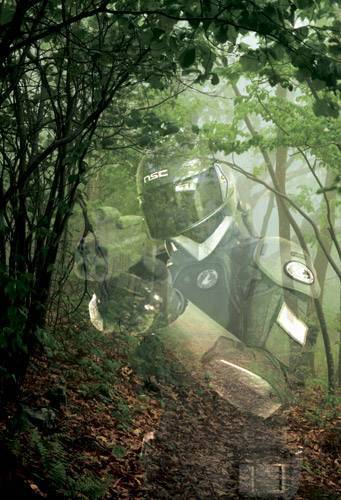 The feats that an ordinary soldier could accomplish in a few years could not even be dreamed of by the creators of the Terminator.
The feats that an ordinary soldier could accomplish in a few years could not even be dreamed of by the creators of the Terminator.Ji Ai Joe easily rose from the position set among the high grass, swiftly ran across a broad clearing, silently dived into the underbrush bushes and lay down facing the edge. Outside glance would not have noticed any movement: while he was lying in the grass, all his clothing, including the helmet and shoes stuffed with electronics, remained the color of the grass permeated by the sun, and darkened under the dense crown of the trees, merging with the background.
Detectors built into the suit fabric an hour ago determined that he had entered the zone of infection. Invisible to the naked eye molecular "umbrellas" opened, tightly clogging the micropores of the fabric and sealing the suit. However, even after rushing through the open space with the 80-kilogram weight behind, the breath remained even, the body was dry, and the inner side “took” the helmet — uncluttered: the outer “skeleton” of the suit (artificial “bones” and “muscles”) was made by JI Joe is stronger than any strongman, the gas mask on the back of the helmet properly supplied the purified air, and the microclimate system maintained the desired temperature.
To look around, Ji Ai Joe touched his finger to the flexible monitor attached to the wrist of his left hand. The rectangle faintly lit up, revealing a series of touch-sensitive keys. One of them made the “visor” of the helmet less transparent and transmitted to it, like on a screen, a panorama of the forest, including what was “seen” at that moment attached to the helmet of the side and rear microcamera. Another key brought the top view of the terrain, obtained from the support satellite. The signals transmitted by the global positioning system were reflected by luminous dots indicating the location in the forest of JI-Jo himself, the rest of the group, and cybermules. From the same "keyboard" he could give commands to a mule or control, for example, the flight of an unmanned vehicle.
The “friend – foe” system showed that so far only ours were around. You could relax. Yesterday scratched from a stray bullet. If he was dressed in a soldier's uniform of previous years, the wound could have been serious, but, instantly solidified at the moment of impact, the thin fabric of his suit extinguished the power of the shot. Having broken through the clothes, the bullet only damaged the skin and muscle of the thigh, and the fabric of the suit immediately tightened, tightly "bandaged" and disinfecting the wound, stopping the blood. The injury was harmless. But he remembered how many friends costumes saved life: hardening in places of fractures, they turned into a medical bus, and when large vessels were damaged, they were not allowed to bleed to death until the approach of the doctors ...
In the meantime, it got dark, but he still perfectly distinguished the smallest details of the area. On the right, a clearly visible thermal “shadow” moved in dashes, but he did not worry: the colored halo around his helmet, visible only to his computer “senses”, suggested that he was approaching his own. This is his partner, JI Ai Jane, pulled up closer to be near at night. Ji Ai Joe again touched the display of the wrist computer and noticed that there were more luminous points. From the side from which they recently came, a chain was moving, each point of which was identified by the “friend – alien” recognition device as a dangerous alien.
Soldiers fired XM29 superlight rifles. Each of them was ready to inflict damage to the enemy, comparable to the attack of the Apache helicopter group.
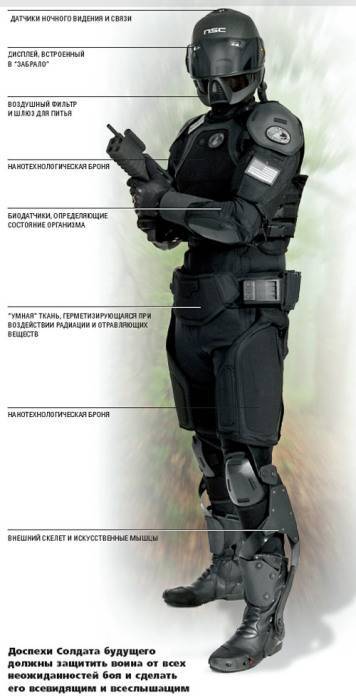 By the path of the "Predator"
By the path of the "Predator"You might think that the described continues the theme of the famous Hollywood blockbuster 1987, Predator. Only the main role is not played by Schwarzenegger - the commander of the special forces, fighting in the wilds of Amazonia with an invisible alien - but ... to the alien himself.
However, it is not. GI Joe and GI Jane are not names. So called American soldiers, male and female. A part of the described sci-fi "miracles" is already embodied in the model of a super suit, which is being developed at the Center for Soldiers' Systems in the city of Natick (Massachusetts, USA). By a strange coincidence, a specialist from Natik, Jean-Louis De Gay, who works on the concept of a Soldier of the Future, bears the same nickname as the hero of Arnold Schwarzenegger - “Dutch”, that is, “Dutchman”.
In an interview taken by Popular Mechanics via e-mail, Mr. DeGay reported that research is underway to create a camouflage “chameleon costume”, the work is planned to be completed in 5 – 10 years, and the appearance of an “external skeleton” and “smart” clothes will have to wait until 2020 – 2025.
“We are currently developing new materials and coatings that help hide the presence of a soldier,” he says. - Research is conducted in the field of active and passive masking, including temperature. As for the other “sci-fi” ideas we are working on, one of the main ones is “communication of all with all”, in which every soldier has the opportunity to “see” all others and every unit of equipment (ground or air, controlled by crew or remotely). All of them become “communication centers”, to which information can be transmitted and from which it can be received. Something similar you may have seen in the Star Trek series (Star Treck). It depicts one of the unearthly races, all of whose members have been assimilated into a single "collective machine." Of course, we are not trying to achieve the same result, but we are trying to introduce “the connection of everyone with everyone.”
As you can see, in the Center, located in 17 km from Boston and, accordingly, not far from the world-famous Massachusetts Institute of Technology, the concept of a Soldier of the Future is described in terms of science fiction.
Natik says that this concept does not have an end point - all the time new ideas will appear on how to improve a fighter: “In this business it is impossible to rest on our laurels, because there is always someone who is trying to defeat you.”
Perhaps that is why the military general Paul Gorman, who began his military career during the Second World War, and in recent years became the guru of military technological innovations, describes the project’s objectives in verse:
“The soldier of our day is thrown forward. // He is the spearhead of the army spear. // There is mortal danger and loneliness. // The soldier of the future will never be alone // And he will attack the enemy, // Covered with a shield of comprehensive information. // His commanders will be able to tell him: // “Soldier! You are the master of the battlefield. // You make the battle what you want. // The network will give you a gift to see everything that you can see. // You will think better of the enemy, // Maneuver faster than the enemy, // Shoot the enemy more precisely. // Strength with you. // Strength in you.
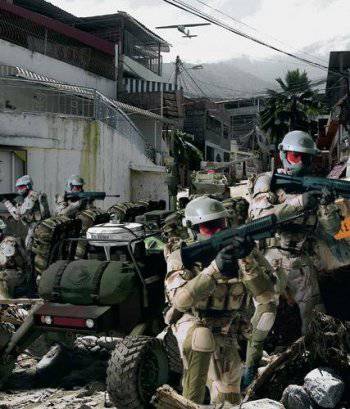 On the way to the Force
On the way to the ForceUntil now, the developers of military uniforms and equipment were engaged in the fact that they gradually improved the existing samples. The ideologists of the “Soldier of the Future” program, designed for about three decades, decided to throw today's concepts into landfills. stories and create a system of individual protection of a soldier from scratch.
The idea was born in 1999 year. Then the chief of staff of the US Army, General Eric Shinseki, announced a reorganization plan that included the creation of future ground-based combat equipment and equipment for the Future Soldier. Developed on the basis of the most promising technology concept entrusted to the National Laboratory in Oak Ridge (Tennessee). 23 May 2002 of the project from the Center in Natik showed at a press conference a prototype of a soldier’s uniform, which the Pentagon called Objective Force Warrior until recently. This name can be translated poetically: "Warrior of the Incarnate Power." Now the name of the project has changed to “Future Warrior Warrior” (more prosaically, this term means “warrior of the armed forces of the future”).
At the first stage, the US military leadership chose two competing research companies - Eagle Enterprise and Exponent - to create the basic concept. Each of them received $ 7,5 million. Through 8 months, General Dynamics (Eagle Enterprise - its component) was chosen to continue the work, which received an order worth $ 100 million to complete the concept. Creating the entire system over 10 years is estimated from $ 1 to $ 3 billion.
As a result, the soldier will not have to wear clumsy night vision goggles, bug-eyed infrared glasses or heavy laser equipment on his helmet: temperature and chemical-biological sensors, as well as video cameras will be mounted directly into the helmet. The inner part of his "visor" will turn into a kind of 17-inch computer monitor. The physiological sensors built into the overalls will allow not only the fighter himself, but also the doctors to track his blood pressure, pulse, body temperature through the wireless Internet, and to come to the rescue if they are injured or ill, knowing the diagnosis.
The internal microclimatic system is built into the fabric not much thicker than that of a regular T-shirt. The material is mottled with “capillaries” that deliver warm or cool air, and is powered by mini-batteries that work on steroids.
All of the above eliminates the need to carry extra weight with you and almost halves the weight of clothing and equipment. If today an American soldier performing a combat mission in Iraq or Afghanistan has to carry up to 40 kg, not including weapons and food supplies, then the weight of all clothes and chemical and biological protection of the Incarnate Force Warrior will not exceed 20 kg.
To transport additional cargo, this universal soldier will be given a robomula that will not only carry weights, including weapons, but will be able to purify drinking water, give additional energy to the whole unit, conduct chemical and bacteriological reconnaissance, communicate and serve as a base station.
Thus, in 10 years, the American army hopes to get a high-tech soldier, twenty times as superior in strength, survival and lethality to his current colleague.
Many technologies already exist and are being finalized, while others are still at the project stage. The latter include, for example, a detailed study of the external skeleton and samples of non-lethal weapons.
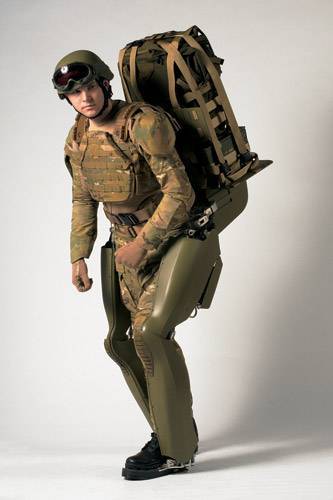 Invisible Cap and Riding Boots
Invisible Cap and Riding BootsThe developers of the concept and technologies of the wonder-soldier consider as their goal not only the creation of a super-war, but also the advancement of whole branches of science and technology on the basis of the project. Therefore, funding for research comes not only from the Pentagon, but also from industrial giants. The latter seek to give the final products a double life - both in the military and civilian spheres. The same approach is followed in the Institute of Military Nanotechnology at the Massachusetts Institute of Technology (MIT) created exactly one year ago. Its programs are funded not only by the military ($ 50 million per 5 years), but also by MIT itself, as well as by industrial giants like Raytheon, Dow Corning and DuPont.
Scientists from DuPont, who are conducting research on the refraction of light, are attracted to creating invisible uniforms. At the same time, EIC Laboratories is working out a competing technology of electrochromic camouflage - a fabric that instantly changes color depending on the color of the surrounding terrain, like a chameleon.
Nanotechnologists from the Institute of Military Technologies are working to create new “self-building” materials that would create themselves after molecule. And the use of nanotubes would give them unprecedented strength properties (we talked more about nanotechnology in the last issue of “PM”).
The working prototype of the external "skeleton" and "musculature" can already be felt. With the money of the Military Technology Development Agency (DARPA), it is created at the University of California at Berkeley.
With the mechanism, which gave the name BLEEX (Berkeley Lower Extremity Exoskeleton), or "skeleton Berkeley external lower limb" can move easily, having shoulders backpack weight 28 kg. It is enough to put on special suits and shoes, connect them together - and you can run and jump like never before: fifty sensors that track the position of the load and hydraulic actuators will not allow you to lose balance.
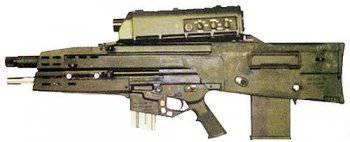 Kladenets sword for a warrior of the future
Kladenets sword for a warrior of the futureBut a super-soldier would not be a soldier, if the tasks of equipping him were limited only to creating physical protection, strengthening muscles and giving a human condition to see and hear what was happening around. It is planned to increase its destructive power, giving into the hands of a new weapon - a double-barreled XM29, exceeding in many respects M16, M4 and M203 by two or three times.
To develop a new rifle has several companies, which acts as an integrator Plymouth ATK Integrated Defense (Minnesota). The first working model of a new small arms was featured in 1999 year, and 2002-m held for shooting accuracy and safety test at a distance of up to 100 500 m, and army experts were given the green light to the continuation of the project.
The lower barrel of the rifle is designed for a standard 5,56-mm NATO cartridge, and the upper one is for an 20-millimeter tearing grenade with combat heads at both ends. After a break at the height of 1,5 meters above the purpose of its fragments fly round, hitting even lying on the ground, or hiding behind the shelter of the enemy. These grenades have a special mode of breaking, the so-called “window”: when faced with glass or a thin metal barrier, they do not explode immediately, like ordinary explosive bullets, but after a few milliseconds.
Equipped with a compass, a laser inclinometer and other devices, optical sight works as a camcorder's lens, allowing you to receive three times magnified image.
The rifle, whose cost is estimated at $ 10 – 12 thousand (for comparison, the M16 price is about $ 1000), consists of two shared parts with a single trigger and programming device. The first is equipped with the same cartridge as the M4 carbine and the M16 rifle, and, like the carbine, can conduct single, semi-automatic and automatic fire. Her shop holds 30 cartridges. The second is a personal “gun” with a six-shooter magazine for 20-mm grenades. It is expected that XM29, which will go into service in special units already 2009 year will weigh on 10-30% less modern M16, M4 or M203.
The new rifle, like all the equipment of the soldier, will be included in its communication and control system, and consequently, in the system of “communication of all with everyone”. Through her "trip computer" all the data go to the built-in "visor" helmet display and at the same time will be available to all members of the unit.
As the entire project Soldier of the future development of his arms broken down into steps, providing for a gradual improvement in sensors and electronics, materials, power systems, wireless communication and digital technologies.
Information